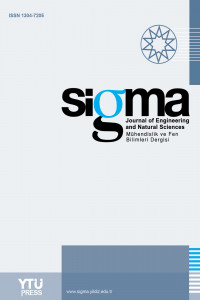FLUORINE ACCUMULATIONS IN DRINKING WATER OF HAVSA DISTRICT (EDIRNE, TURKEY) AND ASSESSMENT OF WATER QUALITY IN TERMS OF TEETH HEALTH
Abstract
This study was carried out to determine the fluorine accumulations in groundwater of Havsa District, where is located in the Edirne Province of Turkey in Thrace Region. Drinking water samples were collected from 15 stations including almost all the residential areas of the Havsa District in winter season of 2016. Fluorine concentrations of water samples were determined by using a spectrophotometer and Cluster Analysis (CA) was applied to detected data in order to classify the groundwater of investigated residential areas according to fluorine contents. Geographic Information System (GIS) was also used in order to make a visual explanation by presenting distribution map of fluorine contents and detected data were evaluated according to national and international quality criteria. And also the detected data were evaluated in terms of teeth health of local people, who constantly drinks this water. According to data observed, the fluorine concentrations in the Havsa District were determined between 0.006 ppm (Bakışlar Village) – 0.567 ppm (Hasköy Village). According to the results of CA, 2 statistically significant clusters were formed as “Updistrict Cluster” with higher fluorine contents and “Downdistrict Cluster” with lower fluorine contents.
Keywords
Havsa District fluorine drinking water quality cluster analysis geographic information system (GIS) teeth health
References
- [1] Anonymous (2012). Edirne İl Çevre Durum Raporu (Environment Status Report of Edirne Province). Edirne Valiliği, Çevre ve Şehircilik İl Müdürlüğü. [In Turkish].
- [2] ATSDR (Agency for Toxic Substances and Disease Registry) (2003). Toxicological Profile for Fluorides, Hydrogen Fluoride and Fluorine. Atlanta, GA: U.S. Department of Health and Human Services.
- [3] Browne, D., Whelton, H., Mullane, O. D. (2005). Fluoride Metabolism and Fluorosis. Journal of Dentistry, 33:177–186.
- [4] Canter, L. W. (1987). Groundwater Quality Protection. Lewis Publications, Inc, Chelsea, MI.
- [5] Cruz, M. J. M., Coutinho, C. A. M., Gonçalves, M. V. P. (2015). The Dental Fluorosis on Santana Karst Region, Bahia State, Brazil. Journal of Geography and Earth Sciences, 38 82):51-67.
- [6] Çiçek, A., Bakış, R., Uğurluoğlu, A., Köse, E., Tokatlı, C. (2013). The Effects of Large Borate Deposits on Groundwater Quality. Polish Journal of Environmental Studies, 22 (4): 1031-1037.
- [7] EC (European Communities) (2007). European Communities (drinking water) (no. 2), Regulatıons 2007, S.I. No. 278 of 2007.
- [8] Fawell, J., Bailey, K., Chilton, J., Dahi, E., Fewtrell, L., Magara, Y. (2006). Fluoride in Drinking-Water. WHO Drinking-water Quality Series, World Health Organization, Geneva.
- [9] Fejerskov, O., Larsen, M. J., Richards, A., Baelum, V. (1994). Dentaltissue Effects of Fluoride. Adv Dent Res, 8:15–31.
- [10] GómezHortigüela, L., PérezPariente, J., García, R., Chebude, Y., Díaz, I. (2013). Natural Zeolites From Ethiopia for Elimination of Fluoride From Drinking Water. Sep Purif Technol, 120:224–229.
- [11] Guner, S., Bozkurt, U. S., Haznedaroglu, E., Mentes, A. (2016). Dental Fluorosis and Catalase Immunoreactivity of the Brain Tissues in Rats Exposed to High Fluoride Pre - and Postnatally. Biological Trace Element Research, 174 (1): 150–157.
- [12] Güner, Ş., Haznedaroğlu, E., Sezgin, B. I., Okutan, A. E., Menteş, A. (2017). Prevalence of Dental Caries and Fluorosis in Two Towns of Edirne, Turkey. Caries Res, 51:290–385.
- [13] Horowitz, H. S., Heifetz, S. B., Meyers, R. J., Driscoll, W. S., Korts, D. C. (2004). Evaluation of a Combination of Self-Administered Fluoride Procedures for Control of Dental Caries in a Non-Fluoride Area: Findings After 2 Years. Caries Res 1977;11: 178–85.
- [14] Edirne İl Kültür ve Turizm Müdürlüğü http://www.edirnekultur.gov.tr/
- [15] T.C. Havsa Kaymakamlığı http://www.havsa.gov.tr/
- [16] Danaher, Danaher https://tr.hach.com/
- [17] Hudak, P. F. (1999). Chloride and Nitrate Distributions in the Hickory Aquifer, Central Texas, USA. Environment International 25 (4), 393–401.
- [18] Li, Y., Liang, C., Slemenda, C. W., Ji, R., Sun, S., Cao, J., Zhang, Y. A. N. (2001). Effect of Long‐Term Exposure to Fluoride in Drinking Water on Risks of Bone Fractures. Journal of Bone and Mineral Research, 16(5), 932-939.
- [19] Liu, H., Gao, Y., Sun, L., Li, M., Li, B., & Sun, D. (2014). Assessment of Relationship on Excess Fluoride Intake from Drinking Water and Carotid Atherosclerosis Development in Adults in Fluoride Endemic Areas, China. International journal of hygiene and environmental health, 217(2), 413-420.
- [20] Mullane, D. M., Baez, R. J., Jones, S., Lennon, M. A., Petersen, P. E., Rugg-Gunn, A. J., Whitford, G. M. (2016). Fluoride and Oral Health. Community Dental Health, 33(2), 69-99.
- [21] SKKY (Su Kirliliği Kontrol Yönetmeliği) (2015). Yüzeysel Su Kalitesi Yönetimi Yönetmeliğinde Değişiklik Yapılmasına Dair Yönetmelik. Yayımlandığı Resmi Gazete: Tarih 15 Nisan 2015, Resmi Gazete No: 29327. [In Turkish].
- [22] Taghipour, N., Amini, H., Mosaferi, M., Yunesian, M., Pourakbar, M., Taghipour, H. (2016). National and Sub-National Drinking Water Fluoride Concentrations and Prevalence of Fluorosis and of Decayed, Missed, and Filled Teeth in Iran from 1990 to 2015: A Systematic Review. Environmental Science and Pollution Research, 23 (6): 5077–5098.
- [23] Tokatlı, C. (2014). Drinking Water Quality of a Rice Land in Turkey by a Statistical and GIS Perspective: İpsala District. Polish Journal of Environmental Studies, 23 (6): 2247-2258.
- [24] Tokatlı, C. (2017). Groundwater Quality Monitoring of a Significant Habitat in Trakya University: Balkan Arboretum Area (Edirne, Turkey). Sigma Journal of Engineering and Natural Sciences, 35 (4): 737-742.
- [25] TS 266 (Türk Standartları Enstitüsü) (2005). Sular-İnsani tüketim amaçlı sular. Türk Standartları Enstitüsü, ICS 13.060.20 [In Turkish].
- [26] WHO (World Health Organization) (2011). Guidelines for Drinking-water Quality. World Health Organization Library Cataloguing-in-Publication Data, NLM classification: WA 675.
Details
| Primary Language | English |
|---|---|
| Subjects | Engineering |
| Journal Section | Research Articles |
| Authors | |
| Publication Date | September 1, 2018 |
| Submission Date | February 9, 2018 |
| Published in Issue | Year 2018 Volume: 36 Issue: 3 |
IMPORTANT NOTE: JOURNAL SUBMISSION LINK https://eds.yildiz.edu.tr/sigma/


